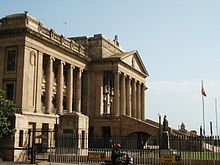Due to Ceylonese demands for constitutional reform, a royal commission was established by the British authorities under the chairmanship of the Earl of Donoughmore. The Donoughmore Commission arrived in the colony in 1927, before returning to the United Kingdom where it issued its report. The Commission proposed reforms which were implemented as the so-called Donoughmore Constitution, resulting in the abolition of the Legislative Council of Ceylon as the colony's legislature, and its replacement by a "State Council" in 1931.
The structure and working of the State Council was experimental, and was based in part on the United Kingdom's London County Council. The State Council functioned in both an executive and legislative capacity, with seven committees performing executive duties. Each committee consisted of designated members of the State Council, and was chaired by an elected Ceylonese who was addressed as minister. The Ceylonese ministers formed a board of ministers with three British officials of ministerial rank who handled defence, external affairs, finance, and judicial matters.
The Donoughmore Constitution was not considered a great success, and this combined with Ceylonese demands for further constitutional reform led to a new commission being established, under the chairmanship of Lord Soulbury, which arrived in Ceylon in 1944. Based on the report by the Soulbury Commission, a new constitution was created, by which the State Council was replaced by a Parliament, elections for which were conducted in 1947. Negotiations with Ceylon's newly elected government resulted in the British granting Ceylon independence as a dominion in 1948.
